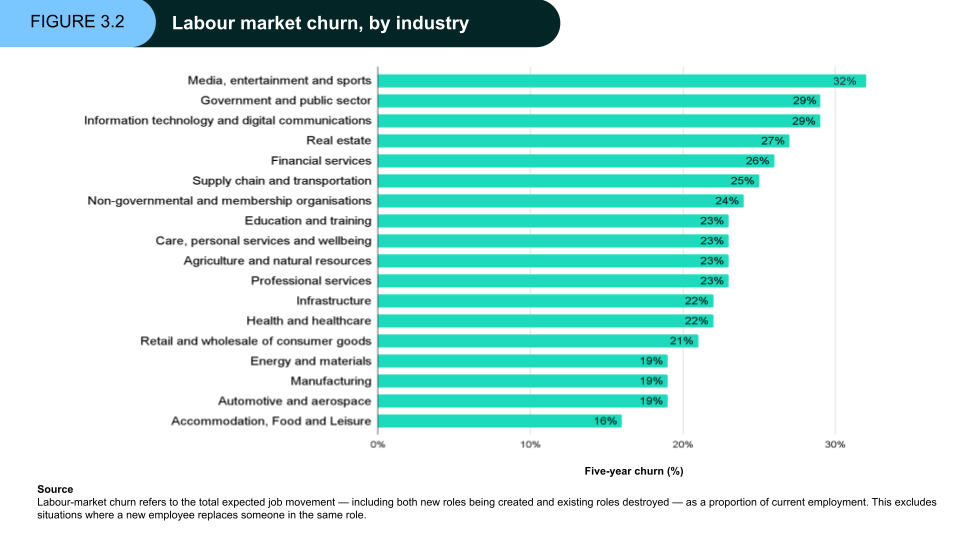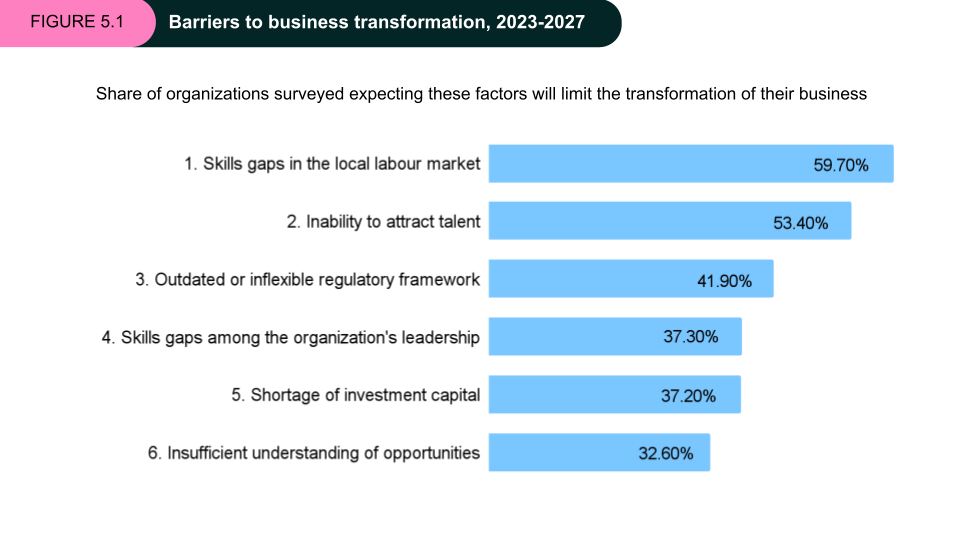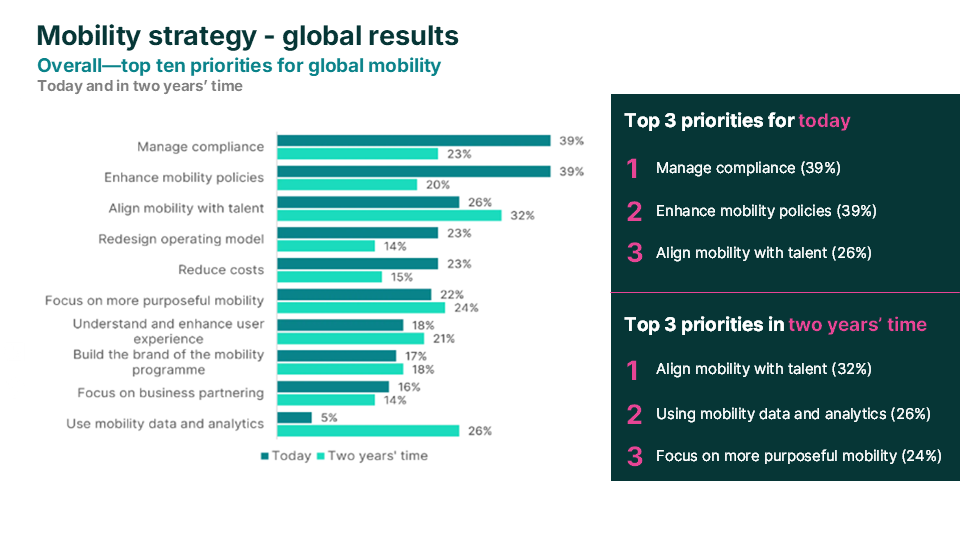Combining mobility data and in-depth analytics offers APAC enterprises a powerful tool to tackle the talent crunch
The integration of technologies like AI, big data, and automation is reshaping all areas of business operations. At the same time, macro trends such as growing geopolitical divides, supply chain diversification, and the rising cost of doing business are fuelling this transformation.
In its Future of Jobs Report1, the World Economic Forum predicts that every industry will experience significant changes in workforce dynamics and job transitions. The media sector is projected to face the greatest impact, with 32 percent of new positions being newly created or replacing existing ones. The public sector is also set for substantial transformation, with a forecasted 29 percent shift in its workforce. Other essential sectors are not far behind, indicating that nearly every facet of our daily and professional lives will be affected.
Labour transformation in the next five years
 Source: World Economic Forum, Future of Jobs Survey 2023.
Source: World Economic Forum, Future of Jobs Survey 2023.
That trend correlates with developments in the immigration space, with regions like Australia, New Zealand, Singapore, and Japan, automating some of their visa decision-making and using biometrics for border control. Most territories regions, including Hong Kong, already have some form of online immigration filing system in place.
The good news is that most of these developments should have a net positive impact in APAC. However, there are also obstacles. Challenges include local skills gaps and an inability to attract talent, with a staggering 60 percent1 of companies citing these two factors as major barriers to transforming their business.
Talent gaps — barriers to transformation
 Source: World Economic Forum, Future of Jobs Survey 2023.
Source: World Economic Forum, Future of Jobs Survey 2023.
What does all of this spell for the Global Mobility industry? According to Vialto’s New Work Journey Survey2, a shakeup is clearly on the cards, with mobility becoming a much bigger focus. The survey predicts that aligning mobility with talent will rise from third spot to first place in terms of priorities in the next two years—overtaking compliance, which is today’s top concern. Enhanced use of mobility data and analytics will claim the second place on the priorities list according to respondents.
 Source: Vialto Partners New Work Journey Survey: “Mobility (R)evolution – Redefining the mobility playbook
Source: Vialto Partners New Work Journey Survey: “Mobility (R)evolution – Redefining the mobility playbook
Data analytics and storytelling: From insights to action
Analytics lies at the intersection of data and human mobility and can be divided into four main categories: descriptive, diagnostic, predictive, and prescriptive. Each type can provide a unique lens through which organizations can enhance their understanding and management of mobility.
Descriptive analytics serves as the backbone for reporting, focusing on understanding the “what” of a situation. By aggregating data from multiple sources, it reveals trends and offers insights into past events. In the context of mobility, examining reports from business reviews can help identify shifts in immigration patterns, uncovering the reasons behind those changes by tracking international migration trends.
Diagnostic analytics is about explaining “why” something happens. A common application could involve analyzing visa approval rates, such as comparing approval versus rejection rates and identifying recurring factors or issues that contribute to unsuccessful applications.
Predictive analytics helps forecast outcomes and support decision-making. In the mobility landscape, it is commonly used to analyze employee data, predicting internal mobility trends and identifying potential candidates for international assignments. When combined with government data, it can also anticipate broader trends and assist in workforce planning.
Prescriptive analytics is the “how.” It takes insights from predictive analytics and transforms them into actionable strategies. This type of analytics is invaluable for situations such as crisis management. By analyzing past events like pandemics, organizations can develop models that predict various scenarios and suggest proactive measures for future situations. It can also assist in expansion efforts, identifying ideal locations for new offices by assessing workforce availability and skill gaps.
Next steps
Many businesses have made significant investments in terms of human capital management systems, making it an excellent opportunity to leverage data for maximum ROI. While understanding different types of analytics is important, the key is defining the problem to be solved. With a clear objective, raw data can be transformed into actionable insights that align mobility strategies with talent needs, as highlighted in the New Work Journey Survey2 as well as the Vialto talent dashboard demonstrated during the recent APAC mobility week.
Contact us
For a deeper discussion on the above, please reach out to your Vialto Partners point of contact, or the following team:
Yang Li, Partner and APAC Immigration Leader
Irin Ou, Director, Vialto Partners
RELATED CONTENT
Read the related case study: Accelerating immigration compliance and workforce planning with data analytics
1 World Economic Forum, “Future of Jobs Report 2023”
2 Vialto Partners New Work Journey Survey: “Mobility (R)evolution – Redefining the mobility playbook”
3 Forbes, “From Expense to Investment: Human Capital—A Driver of Business Value”, October 1, 2024
The information provided herein is for general informational purposes only and does not constitute legal, tax, or professional advice. Use of this information or website does not create a client or professional relationship. For tailored advice, consult a qualified professional. Vialto Partners, a wholly owned subsidiary of CD&R, and its global network (“Vialto”) make no warranties, express or implied, regarding the accuracy, completeness, or reliability of the content herein or otherwise. Vialto disclaims all liability, including indirect or consequential losses, arising from reliance on this information. Use of third-party links is for convenience only and does not imply endorsement or association. All content is the property of Vialto Partners or its designated owner and may not be reproduced or redistributed without permission. Reliance upon the information herein and the use of this site is at your own risk and subject to our Terms and Conditions of Use and Privacy Policy.
© 2025 Vialto Partners. All Rights Reserved.
Let's connect
Please reach out if you’d like to learn more about Vialto.